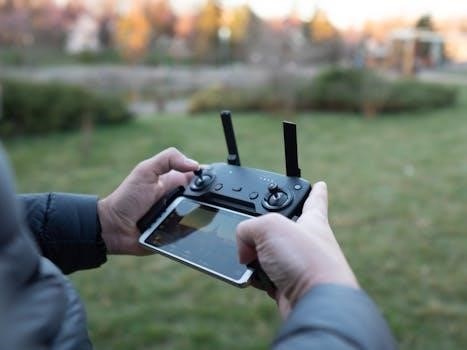Daikin Mini Split Remote Control Manual⁚ An Overview
This section provides a general introduction to Daikin mini split remote control manuals. These manuals are essential for understanding the functions and proper operation of your Daikin air conditioning system. They offer detailed instructions and valuable information for users.

Finding Your Daikin Remote Control Manual
Locating your Daikin remote control manual is crucial for optimal use and maintenance. Often, the manual is included in the packaging with your mini-split system. If you’ve misplaced the physical copy, don’t worry; Daikin provides digital versions online. Many websites, including ManualsLib, offer a wide range of Daikin remote control manuals in PDF format. These manuals are typically organized by model number, making it easier to find the specific guide for your remote. Look for the model number on the remote itself or on the indoor unit. Once you have the correct model number, you can easily download the corresponding manual. You can also check Daikin’s official website for manuals and other resources related to your particular Daikin remote control. These online manuals can be downloaded and saved for future reference.
Types of Daikin Remote Controls
Daikin offers a variety of remote controls for their mini-split systems, each designed with specific features and functionalities. There are primarily two categories⁚ wireless and wired remote controls. Wireless remotes are the most common, offering convenience and portability, while wired remotes are typically installed on a wall and provide a more permanent control point. Within these categories, there are numerous models, each with unique button layouts and capabilities. Some Daikin remotes include hidden buttons behind a sliding panel, while others have programmable features. Some models also feature smart control capabilities, allowing integration with home networks for remote operation. It is important to identify the specific model of your remote control, as each model has its own set of instructions and features. This ensures you use the correct guide for your particular device. You may find different models with varying button layouts and functions, so accurate identification is key.

Common Features of Daikin Remotes
Daikin remote controls, despite variations in models, share several common features designed to enhance user experience. Most remotes include basic function buttons such as power, mode (cool, heat, auto, dry, fan), and temperature adjustment. Many remotes also have a fan speed control, allowing users to adjust the airflow. Another common feature is a timer function, which enables users to set the unit to turn on or off at a specific time. Some Daikin remotes have a “Quiet” mode for reduced noise operation and a “Turbo” mode for rapid cooling or heating. Many remotes include a “Sleep” mode that gradually adjusts the temperature for comfortable sleep. Some remotes feature a “Smart Control” button for network connectivity and advanced settings. It’s also common for Daikin remotes to have an LCD screen that displays settings. Many Daikin remotes have hidden buttons for advanced functions, usually revealed by a sliding panel.
Daikin Remote Control Operation
This section details how to use your Daikin remote control, covering basic functions like power, mode, and temperature settings. It also explores more advanced features and smart controls for optimal use;
Basic Functions⁚ Power, Mode, Temperature
The Daikin remote control’s primary functions revolve around the power, mode, and temperature settings. The power button, typically a distinct symbol, activates or deactivates the system. The mode button lets you select between cooling, heating, dehumidifying, or fan-only operations, depending on your needs. Temperature adjustment is managed using up and down buttons, allowing for precise climate control. These basic functions are crucial for daily operation and ensure your comfort; Furthermore, understanding these controls is the foundation for utilizing the more advanced features of your Daikin system; Remember to aim the remote directly at the indoor unit for proper signal transmission. The display on your remote will confirm the selected settings. Correctly using these buttons ensures efficient and effective climate control within your space. By familiarizing yourself with these core features, you’ll have a better experience with your Daikin mini-split system. These simple adjustments are key to enjoying optimal comfort.

Hidden Buttons and Programmable Settings
Daikin remote controls often incorporate hidden buttons and programmable settings to enhance functionality. Many remotes feature a sliding panel or cover that conceals additional buttons. These hidden buttons may include functions like “Quiet,” “Turbo,” or “Sleep” mode, providing specific operational options. Programmable settings allow for customization, such as setting timers for automatic on/off cycles or adjusting fan speed. These features maximize energy efficiency and comfort. Exploring these advanced settings can significantly enhance your overall experience with the Daikin mini-split system. To access these functions, locate any sliding panels on the remote. Consult your specific remote manual for detailed instructions on programming. Utilizing these hidden and programmable features allows for a more personalized climate control experience. Understanding these options ensures that you can tailor the system to your specific needs. By leveraging these settings, you’ll maximize the performance of your Daikin system. These features allow for precise control.
Using Smart Control Features
Daikin mini-split systems often include smart control features, enhancing convenience and accessibility. These features can be accessed via a dedicated button on the remote or through a mobile app, depending on the model. Smart control allows users to manage their air conditioning system remotely, offering control over various functions. These functions include temperature settings, operating mode adjustments, and scheduling. The smart control button on the remote often enables or disables these advanced features. Connecting the system to your home network allows remote access. Mobile apps provide a user-friendly interface to monitor and adjust settings, even when you’re away from home. This is particularly useful for optimizing energy consumption. The smart control system may also include features such as alerts and notifications. Some models may even integrate with smart home platforms. Check your specific model’s manual for detailed guidance on connecting and utilizing these advanced features. Smart controls enable a more flexible approach to climate management. These functions can significantly improve your overall satisfaction with the Daikin system by providing an enhanced user experience.
Troubleshooting and Maintenance
This section addresses common issues and maintenance procedures for your Daikin remote control. It covers problems like unresponsiveness, battery replacement, and temperature discrepancies. Following these steps can help maintain optimal performance.
Remote Control Not Responding
If your Daikin remote control is not responding, there are several troubleshooting steps you can take. First, ensure that the batteries are correctly installed and have sufficient charge; replacing them with new ones is a good first step. Verify that there are no obstructions between the remote and the indoor unit, such as curtains or furniture. The remote needs a clear line of sight to transmit signals. Try moving closer to the indoor unit, as distance can sometimes affect signal strength. Check the remote for any physical damage, like broken buttons or a cracked casing. If those steps do not resolve the issue, try resetting the remote by removing the batteries for a few minutes, then reinserting them, which can sometimes clear any internal errors. If the problem persists, consult your specific model’s manual or contact Daikin customer service for further assistance. Remember to keep the manual handy for future reference when such issues arise, it provides specific troubleshooting guidance for your model. Ensure the transmitter is aimed correctly towards the indoor unit.
Battery Replacement
Replacing the batteries in your Daikin remote control is a straightforward process, but it’s essential to do it correctly to ensure continued operation. Typically, the battery compartment is located on the back of the remote, often behind a small, sliding cover or a screw-secured panel. Open the compartment carefully, taking note of the battery orientation. Remove the old batteries, usually AAA or AA size, and dispose of them properly according to local regulations. Insert the new batteries, making sure they are aligned according to the polarity markings (+ and -) inside the compartment. Incorrect battery placement can prevent the remote from working. Close the battery compartment securely. Once the new batteries are installed, test the remote by pressing a button to see if the indicator light illuminates and the indoor unit responds. Always use new, high-quality batteries for optimal performance and to avoid potential leakage which could damage the remote. If the remote still doesn’t work after replacing the batteries, then consider other troubleshooting steps; It’s always a good idea to refer to your Daikin remote control manual for specific instructions related to your model.
Temperature Discrepancies
Experiencing temperature discrepancies between the setting on your Daikin remote control and the actual room temperature can be frustrating. Several factors may contribute to this issue. First, ensure that the remote is aimed directly at the indoor unit and that there are no obstructions like curtains or furniture blocking the signal. The remote’s thermostat sensor might be influenced by its location or by nearby heat sources. Verify that the remote’s batteries are fresh, as low battery power can affect its accuracy. If the issue persists, check that the indoor unit’s air filter is clean, as a dirty filter can hinder proper airflow and affect temperature readings. The unit’s location and the room’s insulation may also play a role. In some cases, the temperature sensor within the indoor unit may need calibration or replacement. If the troubleshooting steps do not resolve the problem, it is advisable to consult your Daikin remote control manual or contact customer service for assistance. It’s also good to ensure the unit is operating in the right mode for temperature control.
Additional Resources
For further assistance, Daikin provides various resources. These include online manuals, customer service, and other support materials. Utilizing these resources can help resolve any issues or questions you might have.

Downloading Daikin Manuals Online
Accessing your Daikin remote control manual online is a convenient way to find the information you need. Daikin offers a variety of manuals in PDF format, easily downloadable from their official website or other authorized sources like ManualsLib. These digital manuals provide comprehensive guides, troubleshooting tips, and detailed instructions for operating different Daikin remote control models. To locate your specific manual, you can often search by model number or browse through an alphabetical listing. These resources ensure that you can quickly find the necessary documentation. You may find user manuals, operating guides, and service manuals available for download, helping you navigate through the functionality of your Daikin system. Remember to keep these manuals accessible for future reference. Additionally, many third-party websites may also host these manuals, but it’s advisable to prioritize Daikin’s official website for the most accurate and up-to-date information.
Contacting Daikin Customer Service
If you encounter difficulties with your Daikin remote control or need further assistance after consulting the manual, reaching out to Daikin customer service is a great option. Daikin provides various channels to connect with their support team, ensuring you receive the help needed to resolve any issues. You can contact them via phone, often through a dedicated customer service hotline, or through their online support system; These support channels can assist with technical questions, troubleshooting, and replacement parts. Daikin customer service representatives are well-versed in their products and can guide you through complex problems. Prior to contacting customer service, it’s beneficial to have your model number and any other relevant details readily available. Additionally, their website may offer FAQs and online chat options that could address your questions quickly. Daikin aims to offer comprehensive customer support to help maintain the proper functioning of your mini-split system.
